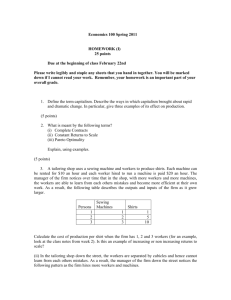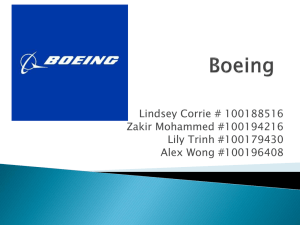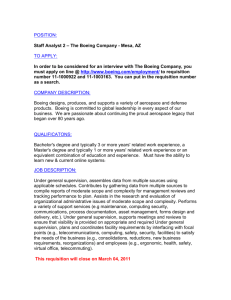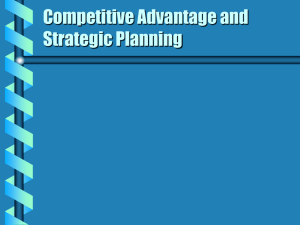Boeing
advertisement
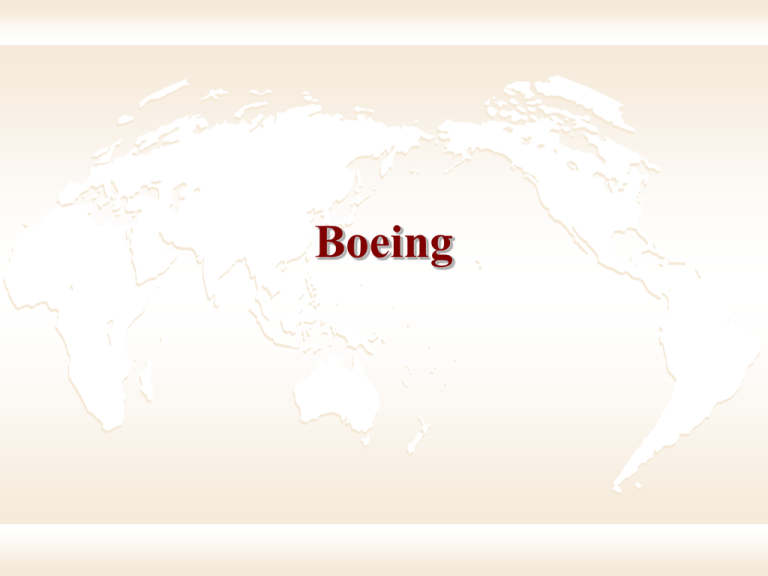
Boeing Summary Boeing was a leader in the aircraft industry, until it met its competitor, Airbus, in the 1970’s. Boeing’s biggest mistake was ignoring this strong competitor, and assuming that business would remain the same. However, this arrogant approach led to a loss of market share, and total profits. Summary Boeing’s acquisition with Rockwell International defense business and McDonnell Douglas helped Boeing regain some of the market share, and profits that were lost to Airbus. Boeing’s arrogant approach to competition Boeing focused too much on retaining its 60% market share, and not enough on it’s competitor’s strategies. Once Boeing acknowledged the strength of their competitor, they attempted to secure larger orders. However, because of their inefficient production system, they were unable to keep up with the numerous orders coming in, which resulted in delayed deliveries, and loss of customers. Boeing’s arrogant approach to competition Boeing’s focus was on quality and customization, even after 9/11. However, they didn’t take into account that the airline industry was hurting at this time, and was acting solely on cost. Inefficient Production and Strategy Boeing’s production goals demanded more aircrafts to be produced faster than the inventory could get through the supply chain. Boeing has been unable to implement computer processes for company operations, and as a result, their production processes are inefficient. Inefficient Production and Strategy Boeing was focusing too much on short term conditions in creating their strategy which hurt them in the long run. Instead of adequately planning for the future, Boeing reacted to the current market condition which left them unprepared and a step behind the industry. Key Takeaways 3 C’s: Complacency, conservatism, and conceit – Complacency- no longer striving for innovative improvements and are content with current practices – Conservatism- managers did not see changes necessary – Conceit- we are the best mentality and not realizing Airbus’s potential Their 3 C’s mind-set caused them to not predict market place demands. This one sided mind-set can be applied to any other situations and inhibits the ability to see the need for change. Current Conditions Regained market share over Airbus in 2000. Largest producer of aircrafts Largest US exporter 75% of worlds commercial aircrafts are produced by Boeing Set to introduce the new and innovative 787 Dreamliner in 2008 Made changes to reclaim market share as frontrunner of commercial jetliner industry Exam Questions Question 1: What key mistake did Boeing make in selling planes to airline companies after 9/11? – Answer: They focused to heavily on quality and customization and ignored the significance of price. Question 2: What anomaly faced Boeing after the creation of the high-tech 777? – Answer: They were able to create the 777 using all computer designs, but were unable to utilize computers to streamline their operations. Airbus S.A.S. the Basics 1970 consortium: Aerospatiale (France) and Deutsche Aerospace (Germany) CASA (Spain in 1971) A300, the first twin-engine wide body airliner Streamline Operations 2001 formed The European Aeronautic Defense and Space Company (EADS) David vs. Goliath Commercial airline production became a commodity business because of low differentiation, this creates pricebased competition Airbus has a much smaller production capacity, but more efficient production, this means they can compete with Boeing on price, even though they are smaller and thus gained market share A3XX SuperJumbo Airbus A380 Double Decker 555-800 seats! Duty Free Shops w/...Casino! A3XX SuperJumbo Do you think Airbus’ more passenger A380 friendly designs give it Airbus a significant competitive advantage? Why or why not? ....Who is the Customer? the Talk What is Airbus’s forecast concerning future air travel? How do they plan on preparing? What was the 2005 backlog for Airbus? What does this mean? Sources Ford and Firestone Firestone/Ford Explorer Tire Disaster Ford and Firestone have been doing business together since 1895 The first signs of trouble came in 1999 when 14 fatalities occurred in Saudi Arabia By May 2000 four U.S. fatalities had been reported In December 2000 Firestone blames Ford for the problems In April 2001 Ford blames Firestone for the problems On May 21, 2001 the 95 year association was ended Where the Blame Lies Ford decided to use the less heat resistant C grade tires rather than the more heat resistant B grade tires Also recommended a lower air pressure in tires that helped contribute to the problem Firestone used shoddy manufacturing processes in it’s plant in Decatur, Illinois A majority of the recalled tires came from this plant (Whistle Blower) In reality both were to blame in some aspect Lessons Learned Emotion influences company reputation After incident Bridgestone/Firestone replaced Phillip Morris as having the worst reputation in America Suspicions and complaints about product safety must be thoroughly investigated In the worst case scenario go with an appropriate salvage strategy In the case both companies tried to combat the bad press, denied responsibility, blamed someone else and resorted to the strongest possible legal defense Lessons Learned cont. They should have done what Johnson & Johnson did when someone died from tainted Tylenol Full admission of problem and removal of risk It is expensive but you save money in the long run by avoiding potential lawsuits and saving company image A full recall would have also likely saved many lives Bottom line – the two companies should have worked together to solve the problem instead of Questions 1. If you had been the CEO of either Ford or Firestone how would you have handled the situation? 2. Would you feel safe buying a car mounted with Firestone tires?

